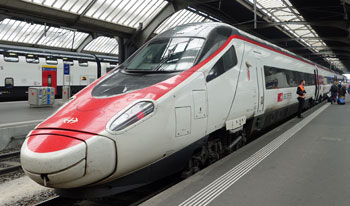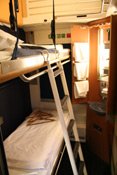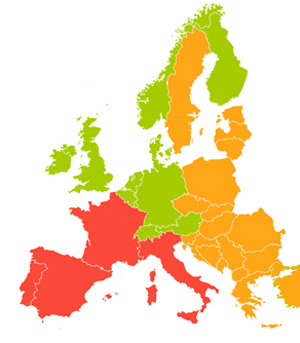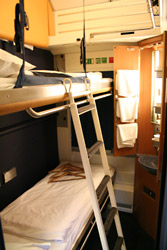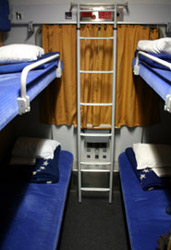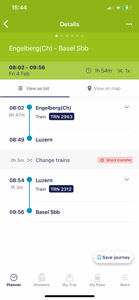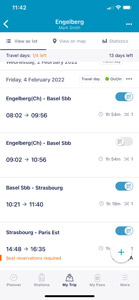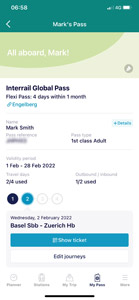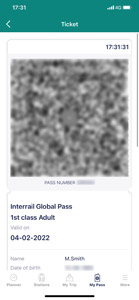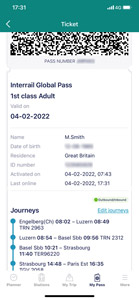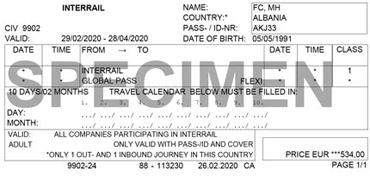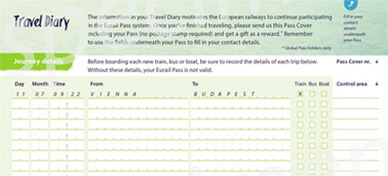|
Buy a pass online at www.eurail.com or www.raileurope.com, load it into the Rail Planner app and activate any time in the next 11 months. More info.
|
|
|
|
Eurail or Interrail?
Before we start, which of Europe's two great railpass ranges applies to you?
![]() If you live in Europe including the UK
you qualify for Interrail,
so hop over to the Interrail page.
If you live in Europe including the UK
you qualify for Interrail,
so hop over to the Interrail page.
![]() If you live in America, Australasia, Asia or Africa you qualify for a Eurail pass, read on.
If you live in America, Australasia, Asia or Africa you qualify for a Eurail pass, read on.
Introducing Eurail passes
Eurail is the railpass range for overseas visitors, giving unlimited train travel across most of Europe with a Eurail global pass, or in the country of your choice with a Eurail single-country pass. This page talks you through buying & using a pass, and whether a pass or point-to-point tickets is best.
|
|
Why see Europe by train: train vs. car, flight, bus |
|
|
|
||
|
|
||
|
|
||
|
|
||
|
|
||
|
|
||
|
|
||
|
|
||
|
|
||
|
|
||
|
|
||
|
|
||
|
|
||
|
|
||
|
|
![]() Eurail map showing train routes in participating countries.
Eurail map showing train routes in participating countries.
Useful train travel information
![]() General information for train travel in Europe
General information for train travel in Europe
![]() Where to buy cheap
point-to-point tickets
Where to buy cheap
point-to-point tickets
![]() Luggage on trains &
luggage storage at
stations
Luggage on trains &
luggage storage at
stations
![]() Sleepers & couchettes
explained
Sleepers & couchettes
explained
Trains, buses, flights or hire car?
Whether you use a Eurail pass or buy point-to-point tickets, the train is the best way to tour Europe, relaxed, in comfort, seeing a lot in a short time. It's not just transportation, train travel is part of the European way of life, the journeys are an experience and in some cases a highlight of your trip. A Eurail pass gives you freedom & flexibility, or you can buy cheap point-to-point train tickets by booking in advance, just as you would with a budget airline.
Things to consider
-
In Europe, cars and city centres don't mix
Hiring a car is a great way to explore the countryside, but to visit cities such as Paris, Rome, Prague, Barcelona or Budapest, hiring a car is a big mistake. It's not like driving in the States. In overcrowded Europe, driving on busy motorways is tedious. European cities are congested, parking non-existent or expensive. There may be fines for entering traffic-free zones. Some car hire companies won't let their cars cross borders, others charge prohibitive fees for one-way cross-border rentals.
-
A 1-hour flight takes 4 hours
With the bus or train to the airport, 2-hour check-in, flight, more airport hassle then another bus, train or taxi into town, a 1-hour flight takes 4 hours. And you miss out on the experience: The train lets you chill out, read, chat, work, meet people and experience Europe - it can even be a highlight of your trip. If you fly you must factor in the extra cost of airport transfers & baggage fees. And short-haul flights cause disproportionate environmental damage.
-
Long distance buses are usually the poor man's choice
Buses travel on ugly motorways which spoil the scenery they pass through. A 3-hour train ride at 186 mph with hourly departures might be an 8-hour endurance test by bus with 2 departures per day. You're stuck in a bus seat, no restaurant or cafe-bar and at night you sleep slumped in a seat. Unlike trains, you may not be allowed to bring your own food & drink, let alone alcohol such as a nice beer or glass of wine. Avoid!
-
Relax by train, city centre to city centre
The rail network covers almost every town & city, with a range of departures every day. Trains run at up to 320 km/h (199 mph), faster than flying for journeys such as London to Paris (2h20), Paris to Amsterdam (3h20), Paris to Geneva (3h05), Barcelona to Madrid (2h30) or Rome to Venice (3h45). Even Paris-Barcelona (6h30) is better by train, with great scenery compared to 5 hours of RER train, airport, flight, airport, then metro. Sleeper trains are an experience, covering huge distances while you sleep, such as Amsterdam-Vienna, Zurich-Prague or Prague-Krakow, saving a hotel bill & avoiding the 4 or 5 daytime hours wasted by flying. Trains are low-hassle, low stress, with loads of legroom, you can wander to the bar or restaurant. Or bring your own picnic and bottle of wine or beer, it's allowed on most trains!
What is a Eurail pass?
-
Eurail is the brand name for the range of railpasses offered to overseas visitors giving unlimited travel on trains run by the national rail operators and various other train operators in 33 European countries, see the list of participating countries below or see the Eurail map.
-
Eurail is not a train operator and there no special 'Eurail' trains. You use the regular scheduled trains run by the participating train operators, the same trains we Europeans travel on.
-
The participating train operators have set up a small Eurail management company to manage both the Eurail & Interrail schemes, based in Utrecht in the Netherlands. They run the official Eurail website www.eurail.com. As it happens, I've been there to discuss scheme improvements with them, nice people!
-
You can choose a pass giving unlimited travel for various periods of time on the national rail networks of all 33 participating countries (Eurail global pass) or just one of those countries (Eurail one-country pass). The different types of Eurail pass are explained here.
-
On many trains you can just hop on and show your pass, but on many long-distance & high-speed trains others you must pay a small fee to make a seat reservation. You also need to pay for sleeping berths on overnight trains. The cost of reservations and how to make them is shown on the Eurail & Interrail reservations page.
-
To understand how Eurail passes work, which trains they cover and how reservations work, see how a Eurail pass works.
-
There are a handful of other railpasses worth knowing about as they are sometimes better value than Eurail, for example the Swiss Pass, Trenitalia Pass & Renfe Spain Pass. These non-Eurail passes are explained here.
Who qualifies for a Eurail pass?
-
You can buy a Eurail pass if you are resident outside Europe, for example in the USA, Canada, Australia, New Zealand, Asia or Africa.
-
If you live in Europe or in Turkey, Russian Federation, Morocco, Algeria or Tunisia you cannot buy a Eurail pass, you qualify for the Interrail pass range instead. Interrail passes cover exactly the same countries & trains as Eurail, with the same fees for the same reservations, so an American and a British traveller can easily travel together, one using a Eurail pass, the other an Interrail pass.
-
Over recent years Eurail passes for overseas visitors and Interrail passes for European residents have converged. Pass types & prices are now identical. The way the Eurail & Interrail passes operate in terms of trains covered and the need for (and cost of) reservations is identical.
Which countries participate in Eurail?
-
The countries participating in the Eurail pass scheme are:
Austria, Belgium, Bosnia, Bulgaria, Croatia, Czech Republic, Denmark, Estonia (new from 2020), Finland, France, Germany, Greece, Hungary, Ireland, Italy, Latvia (new from 2020), Lithuania, Luxembourg, Macedonia, Montenegro, Netherlands, Norway, Poland, Portugal, Romania, Serbia, Slovakia, Slovenia, Spain, Sweden, Switzerland, Turkey & (new in 2019) the United Kingdom.
Eurail does not cover Albania, Ukraine, Belarus, Russia or Moldova.
Eurail pass types explained
It's quite simple: There are One-country or Global Eurail passes, in 1st or 2nd class, for each age group, adult, youth, senior & child.
Who's going?
-
Adult - self explanatory.
-
Senior - for anyone aged over 60 on the first day of pass validity, at 10% less than the adult price.
-
Youth - for anyone aged under 28 on the first day of pass validity (raised from under 26 in 2017).
-
Child - for kids under 12. Children aged 4-11 (inclusive) qualify for a free Eurail pass when they travel with someone over 18 using a Youth, Adult or Senior pass. Although they still need to pay reservation fees! Maximum 2 children per adult. On some retailer's website this is shown as 'family'.
-
Infants - children aged under 4 travel free on trains anyway and don't need any pass, nor do they pay any reservation fees. In some countries the age limit for infants is 5 or even 6, so don't pay if you don't have to, see the age limits for each European country here.
Where are you going?
-
A Eurail Global pass covers all 33 participating countries, see the list or see map of rail network in the Eurail countries.
-
A Eurail Single-Country pass covers just the country of your choice, it's cheaper than buying a global pass covering all countries. A Eurail single-country pass exists for each participating country except Switzerland (for Switzerland, use a Swiss Travel Pass instead). There's a Eurail Scandinavia pass covering all the Nordic countries.
How long for?
-
You can buy Eurail passes giving unlimited train travel for various periods of time. You need to get your head around two different concepts:
-
Continuous passes give unlimited travel every day for a continuous period of time, either 15 days, 22 days or 1, 2 or 3 months, starting on any date you like. These give the ultimate in freedom and flexibility, but to make them worthwhile you need to be on a train every day or two.
With a mobile pass that sits in the Rail Planner app on your phone, you can pick the start date any time in the 11 months after you buy the pass, but if you insist on a hard-copy card pass you have to pick the start date when you buy it.
-
Flexi passes are more economical if you plan to stay put for a number of days between travelling. You can buy a Flexi pass giving 4, 5 or 7 days travel within an overall 1 month period, or giving 10 or 15 days travel within an overall 2 month period.
For example, suppose you buy a 5-days-in-1-month pass in February. There's no need to decide on travel dates when you buy it, you can activate it any date in the following 11 months. Later, you decide you'll use the first of your 5 travel days on 10 July. You activate the pass on 10 July, so the overall 1 month period starts ticking. You can now 'spend' each of the 5 travel days on any dates you like between 10 July & 9 August. You pick 10 July as your first travel day, giving unlimited travel from midnight to midnight. You can then use your remaining 4 travel days on the 12 July, 24 July, 2 August & 9 August or whatever, activating each travel date as you need it - no need to decide in advance. Got it?
1st or 2nd class?
-
You can choose 1st or 2nd class with any pass type.
-
2nd class is absolutely fine, it's the way we Europeans normally travel, unless the Company is paying! Many local trains are 2nd class only, and on many sleeper trains you can access all accommodation types (even deluxe sleepers with toilet & shower) with only a 2nd class pass plus the relevant sleeper supplement.
-
But 1st class seating is available on most longer-distance trains and if you can afford it, 1st class is obviously nicer, with wider, plusher seats, more legroom. In 1st class there are usually more businessmen tapping on laptops and fewer families with kids. Don't assume 1st class gets you any food or drink or free limo transfers or complimentary massages, this is not an airline. Your default assumption should be that 2nd class seating is nice, 1st class seating is nicer, and it's normally just the nicer seating with fewer people per car that you're paying for when you go 1st class. Sometimes a 1st class pass will get you into a first class lounge at a station, but more often than not it won't.
-
What's the difference between 1st & 2nd class? That may help you decide!
Other railpasses
-
As well as the large and well-known Eurail pass range, several countries do their own non-Eurail pass, which can be worth checking. This includes the Swiss Travel Pass for Switzerland (as there is no one-country Eurail pass for that country), the Renfe Spain Pass which is worth considering as a better bet than the Eurail one-country pass for Spain. I've summed these passes up here.
Eurail pass prices
They're priced in euros, but you can buy in your own currency. You can check prices and buy online at the Eurail website www.eurail.com or at www.raileurope.com. As I write this, 1 USD = 0.88, 1 AUD = 0.61. Check current exchange rates.
Check one-country pass prices at www.eurail.com or www.raileurope.com
Buy a pass from www.eurail.com or www.raileurope.com and load it into the Rail Planner app on your phone. More info.
Hard-copy or mobile pass?
-
If you buy at www.raileurope.com you get a mobile pass which can be downloaded instantly and loaded into the Rail Planner app on your phone. If you buy at www.eurail.com you can choose either a mobile pass or a classic hard-copy pass which is sent to you at extra cost. Mobile passes were introduced in 2020 and 97% of people now choose a mobile pass.
-
Advantages of a mobile pass
You download it, delivery is instant and free;
You can activate the pass (in other words, choose the date on which you'll start using it) any date you like in the 11 months after buying it. A printed pass arrives with your chosen start date already printed on it and this cannot be changed;
You only need to enter your passport number when you activate the pass, so it's not a problem if your passport is being renewed or you haven't yet got all your companions' passport details;
The pass is on your phone so you always have it with you, one less thing to carry around;
It's easier to select and add travel diary details on a phone screen than write in biro on a flimsy printed travel diary on a station platform.
I've used a mobile pass many times myself, it's easy to use and works well. You need to connect the app to the internet via WiFi or mobile data at least once every 3 days to keep the app updated and the pass valid, but it works offline in between.
-
Advantages of a hard copy pass
(1) If your phone runs out of battery you can still show a paper pass (but an Anker powerbank solves this and is a good backup plan for your phone anyway); (2) If your phone breaks you can still show a paper pass; (3) You can keep the paper pass as a souvenir afterwards!
-
There's no magic answer
Why? Because in the 21st century, European point-to-point train fares vary like air fares, cheap in advance, expensive at short notice or on popular days or dates. Just like flights!
The cost of a Eurail pass also varies, depending whether it's adult, senior or youth, and whether it's for a shorter or longer period. Longer period passes are better value as the cost-per-day is lower.
The only way to know for sure is to go online and check current point-to-point prices for your specific dates for each journey you plan to make, add them up and compare to the price of a Eurail pass, remembering to factor in the cost of any necessary passholder reservation fees.
You can check point-to-point prices by selecting the starting city here, I'll tell you which website to use to check fares for that specific route.
But it's not all about price, it's also about flexibility. This example may help:
-
How much is a point-to-point ticket?
Assume you plan to go from Prague to Berlin:
- 18.99 is the cheapest possible advance-purchase fare, price varies like air fares, specified train only, no changes, no refunds.
- 95 is the fully-flexible fare which can be bought on the day, unlimited availability, good for any train.
Assume that a few days later you plan to go from Berlin to Amsterdam:
- 37.99 is the cheapest possible advance-purchase fare, price varies like air fares, specified train only, no changes, no refunds.
- 167 is the fully-flexible fare which can be bought on the day, unlimited availability, good for any train.
-
How much is a Eurail pass?
If you divide the pass cost by the number of days travel, you get a cost-per-day. The longer the pass duration, the cheaper the cost-per-day:
- 64 per day using a 5-days-in-1-month Eurail global pass (5-day price divided by 5)
- 45 per day using a 10-days-in-2-months Eurail global pass (10-day price divided by 10)
Or if you're aged under 28 and can buy a youth pass:
- 48 per day using a 5-days-in-1-month youth Eurail global pass.
- 34 per day using a 10-days-in-2-months youth Eurail global pass.
A pass gives you unlimited travel, so you can use any train you like, as if you'd bought the fully-flexible ticket. Better, as you could go up & down on trains between Prague & Berlin all day if you wanted, or carry on beyond Berlin to Cologne or Hamburg.
-
So is a pass cheaper?
No, point-to-point advance-purchase tickets are cheaper, it's not a trick question! Prague-Berlin from 18.99, Berlin-Amsterdam from 37.99.
And easiest too, easy to buy online at the German Railways website and show on your phone. Click, click, booked!
So if you're only planning 2, 3 or maybe 4 such trips on fixed dates, your accommodation is pre-booked and you're happy to commit to specific trains 2-3 months in advance on a no-refunds, no-changes basis, then advance-purchase tickets are usually cheapest & easiest.
-
But at short notice or on popular dates, a pass might save money
Remember these are the cheapest possible advance-purchase fares. On your date, prices may be higher, especially at popular times of year. And if you need to go tomorrow or next week so cannot book months in advance, a pass can be cheaper than short-notice point-to-point fares.
-
A Eurail pass makes sense if you value flexibility
Even when it costs more than advance-purchase tickets, a pass may still make sense because it is flexible. It's significantly cheaper than the fully-flexible fare for most longer-distance journeys.
With an advance-purchase ticket you're nailing your plans to the floor months in advance. Trading up to a pass gives you the freedom to travel when you want, or even decide not to go to Prague after all, but to Vienna instead. A Eurail pass gives unlimited travel all day, so you can make additional journeys the same day, before or after this one.
-
For extensive itineraries, a pass is better
For extensive itineraries, using a stack of advance-purchase point-to-point tickets might be cheaper, but it's risky. If a flood, fire, strike or landslide knocked out one journey, the rest of the trip could come crashing down like a house of cards as advance-purchase tickets become worthless if you miss the train. A Eurail pass gives you the flexibility to re-plan, re-schedule or even re-route as necessary.
Mrs 61 and I once travelled from my in-laws in the Netherlands to Italy using passes. The day before our return, a train crash in Belgium blocked our planned route, Milan-Paris-Rotterdam. But with our passes we easily re-routed via Milan-Zurich-Cologne-Rotterdam.
-
But avoid using use a pass for short hops
Vienna to Bratislava costs only 12 or so, Florence to Pisa 9, even bought on the day.
It'd be cheaper to buy a 4-days-in-1-month pass plus a point-to-point ticket for a short hop like this, than to pay an extra 50 for a 5-days-in-1-month pass. Common sense, surely?
-
Remember to factor in the passholder reservation fees
The point-to-point fares you see online always include any necessary reservation. If you use a pass, you may have to pay a reservation fee in addition to the cost of the pass. Here's a rule of thumb:
In France, Italy, Spain, reckon on a 10+ reservation fee for every train other than purely local ones, in addition to the cost of the pass.
However, in Benelux, Switzerland, Germany, Austria, Denmark & most of eastern & central Europe, there are usually no fees to pay (unless you want a sleeping berth), you can just board a train, sit in any empty unreserved seat, and show your pass to the conductor. That's a generalisation, but even if a seat reservation is required in these countries it's typically 3 - 6, the same as any other ticket-holder would pay.
The Prague-Berlin & Amsterdam-Berlin examples above usually involve no reservation fee, unless you choose to reserve a seat.
You need to pay a passholder fare to use Eurostar between London & Paris, Lille, Brussels or Amsterdam. This costs 35 in 2nd class or 40 if you have a 1st class pass, see Eurostar passholder information.
On overnight sleeper trains you need to pay for a sleeping-berth, perhaps 39 for a couchette or 100 for a bed in a 2-bed sleeper.
See a list of Eurail reservation requirements & costs in each country.
My advice, without doing the maths
-
You must decide if you want freedom & flexibility, or are happy to commit to specific trains well in advance. It's a 4-way decision:
(1) Buy a Eurail pass for unlimited flexible travel, remembering that a reservation fee must be paid for certain trains;
(2) Buy full-flex point-to-point tickets as you go - cheap for short hops, expensive for longer distances;
(3) Buy cheap advance-purchase tickets direct from the operator, limited or no refunds or changes to travel plans allowed;
(4) Mix & match these options: Combine a Eurail pass with regular tickets for short hops or pre-planned longer journeys.
It's risky to generalise, but I'll have a go, for those without the patience to do the maths.
-
For a few short train rides
Don't buy a pass! Nice to Cannes is 5, Florence to Pisa 9. A railpass is overkill for a few short local journeys. Obvious, I hope.
-
For 2, 3 or even 4 long train rides where your dates are known & fixed
Don't buy a pass! If you can book 2-3 months ahead, have a fixed itinerary with all your accommodation pre-booked, the cheapest option is to commit to specific trains on a no-refunds-no-changes-to-travel-plans basis using advance-purchase point-to-point tickets bought direct from the relevant operator, following my route-specific advice here.
If you don't really need the unlimited train rides, unlimited distance and unlimited flexibility of a pass, you can save a lot of money this way.
Just remember that if you need to travel tomorrow with all the advance fares sold out, a pass could still be cheaper.
Overseas travel agents often don't know about these cheap advance-purchase train fares, and overseas agency sites often can't access the cheap fares for every route. For example, the ONLY website that can sell those 21 tickets from Prague to Budapest is the official Czech Railways website - I say again, follow my route-specific advice here!
-
For a few long train rides where you DON'T want to nail your plans to the floor
Cheap advance-purchase tickets commit you to specific dates & trains with limited or no changes to travel plans allowed. A pass may well save money over longer-distance full-flex fares bought at the station, if you travel far enough each day, even if it costs more than cheap advance-purchase fares.
-
For an extensive itinerary with many train rides covering several weeks
For a longer trip, say several weeks exploring every major city in Europe or a very long journey such as London to Istanbul, I'd buy a railpass even if advance-purchase fares were cheaper. A Eurail pass allows you to flex your dates, trains and routes as necessary.
-
If you're under 28 years old, consider a pass
The youth Eurail pass compares well with even the cheapest advance-purchase fares. For one or two or three specific journeys, I'd still buy advance-purchase tickets, but for anything more than that consider the pass. Even if it costs a few euros more, the extra flexibility is worth it, giving you the ability to change your mind or divert via another route or train if something goes wrong with one leg of the itinerary. Incidentally, the age limit for Youth passes changed in 2017, anyone under 28 now qualifies for a youth pass, previously it was under 26.
-
If you've kids under 12, consider a pass
The free Eurail passes for children under 12 may swing the balance towards buying a pass, even for a pre-planned itinerary. Now you really have to do the maths, as shown in the next section.
-
You can mix-and-match a pass with point-to-point tickets
For example, for 11 days of train travel in Europe, it's cheaper to buy a 10-day Eurail pass plus one point-to-point ticket for the shortest/cheapest of all your train rides, than to buy the next size up, a 15-day pass. Or if the start of your trip is known and fixed, but you want to stay flexible for the rest, you could buy a cheap ticket for the first journey or two, then use a railpass. And if your plan includes a few short local hops, use point-to-point tickets for those, and buy a cheaper pass with fewer unlimited travel days to cover the longer journeys.
-
To sum up
Perhaps you came to this page thinking that railpasses save money, but these days they often don't. It's more accurate to think of them as trading up to affordable go-as-you-please flexibility. Stands to reason, really. A pass giving unlimited flexible travel all over Europe ought to cost more than a cheap budget ticket for a specific route & train booked two months in advance.
Typical Eurail pass example: Rome - Florence - Venice
-
Eurail passes only make financial sense for Italy if you plan to travel a significant distance every day, or perhaps make two medium-distance trips every day, which few people do.
-
I find people typically go from Naples to Rome, then Rome to Florence, then Florence to Venice, then perhaps Venice to Milan or Cinque Terre, 1 trip per day. Even at the full-flex Base fare bought on the day, this doesn't justify a Eurail pass once you add the 13 passholder reservation fee for every Italian fast train. And if you're prepared to forego flexibility and book cheap no-refunds no-changes advance purchase fares you can save a lot of money over the cost of a pass.
-
So for Italy, only buy a Eurail pass if you have done the maths and factored in the 13 passholder reservation fee for every fast train.
Typical Eurail pass example: Berlin - Prague - Vienna - Budapest
-
If you book a cheap no-refunds no-changes advance fare a couple of months in advance, Berlin-Prague starts from 18.99, Prague-Vienna from 15, Vienna-Budapest from 19.90. This is the cheapest way to make such a circuit if you can book ahead and don't need flexibility.
-
If you want to stay flexible, a Eurail pass can save money over full-flex on-the-day prices.
Typical Eurail pass example: London - Paris - Brussels - Amsterdam
-
Eurail passes now cover Eurostar London-Paris/Brussels, but with a passholder fare of 35 in Standard class or 40 in Plus (1st class).
-
Eurostar (formerly Thalys) Paris-Brussels-Amsterdam charges a 20 passholder reservation fee for Paris-Brussels or 25 Paris-Amsterdam, with even these passholder places limited by quota, meaning you'd better book in advance even with a pass in case the quota runs out. If you book this through an agency, they'll charge you a 10 fee for selling you the 20-25 fee.
-
Booked 2-3 months ahead, you can buy Paris-Brussels tickets from 29 or Paris-Amsterdam tickets from 35 including reservation. I would think long and hard before choosing to make a London-Paris-Brussels-Amsterdam circuit using a pass rather than advance-purchase tickets.
How does a Eurail pass work?
-
Eurail passes give unlimited travel on national & international trains
A Eurail pass gives unlimited travel on all the train services run by the national train operator in all of the countries it covers.
These aren't special 'Eurail trains', these are the normal, regular, scheduled trains in each country, including high-speed trains, sleeper trains, intercity trains, suburban trains & local trains. Both national and international trains.
Unlimited means unlimited: You can take as many trains as you like, 1 train or 20 trains, 8 miles or 800 miles.
Eurail passes also cover certain private train operators, and even a few ferry services. The country-by-country guide explains what train & ferry operators are covered in each country.
You need to make a reservation for a small fee on some trains, more about that below, and pay for a berth on night trains if you want one.
-
Eurail passes don't cover
Metros, trams or buses in big cities as these are usually run by an urban transit authority;
Some small private local train operators such as Euskotren narrow-gauge trains in Spain (Hendaye to San Sebastian to Bilbao) or the Circumvesuviana railway in Italy (Naples-Pompeii-Sorrento);
A few private inter-city operators who compete with the state-owned national operator on some routes, such as Italo trains in Italy or Ouigo trains in Spain. Nor do they cover lo-cost subsidiaries set up by the national operator such as Ouigo in France or Avlo in Spain. If in doubt, see my country-by-country guide.
-
Flexi & Continuous passes
Continuous passes are valid for a continuous period starting on the date you activate the pass. For example, if you activated a 1-month pass on 10 July, it would give continuous unlimited travel from 00:00 on 10 July until 24:00 on 9 August.
Flexi passes have an overall 1 or 2 month validity which starts ticking when you activate the pass. You can then spend each of your unlimited travel days on any dates you like within that overall validity period.
For example, if you activated a 5-days-in-1-month Interrail pass on 10 July, you can spend each of the 5 travel days unlimited travel on any dates you like until 9 August, let's say on the 11 July, 15 July, 17 July, 23 July and 2 August. Or whatever!
Each pass day is good for as many trains, journeys & kilometres as you can cram in from 00:00 to 23:59. In fact, a pass day can cover you beyond midnight if using a sleeper train.
-
How to find train times on which to use your pass
Use the excellent German Railways online timetable at int.bahn.de. It covers pretty much the whole of Europe. Most trains shown in its database can be used with an Interrail pass, although supplements or special fares must be paid on some. It will also show which trains have compulsory reservations.
Or download the Rail Planner app. Go to www.eurail.com/en/plan-your-trip/rail-planner-app and download the Rail Planner app for your phone (please let me know if that link stops working). This is this a great Europe-wide timetable app which you can use to check train times whilst on the move as the timetable works offline, with no mobile data costs. The app also does passholder reservations for Eurostar & Trenitalia high-speed trains. If you buy a Eurail mobile pass, the pass sits in the Rail Planner app on your mobile. The Rail Planner app warns you when a train shown in its search results isn't covered by Eurail.
-
What about ferries, for example Italy to Greece?
A Eurail global pass also gives free travel on Superfast Ferries, Minoan Lines & Blue Star Ferries between Italy (Bari, Brindisi, Ancona or Trieste) and Greece (Corfu, Igoumenitsa or Patras for the train to Athens). A few euros for port taxes needs to be paid, and cabin berths are extra. Superfast and some other ferry operators charge a small summer supplement (about 10 or so), you pay at the port. A Eurail pass also gives a significant discount (typically 30%-50%) on normal fares for some other shipping operators, for example, Silja Line (Stockholm-Helsinki or Stockholm-Turku). There is no longer any discount on Trasmediterranea (Barcelona to Ibiza, Majorca & Minorca and Algeciras to Tangier).
When do you need a reservation?
|
Where do you need reservations? ...an easy rule of thumb |
|
|
|
|
|
Green = Travel freely! Pass-friendly countries, seat reservation usually optional. Yellow = Travel easy! Also pass-friendly, reservation often required, but no big deal, the same 2-5 that any passenger with a full-price ticket pays. Red = All inter-city trains require a special passholder reservation, budget for 10+ a pop. Some international trains to/from France charge 20-40. |
-
The country-by-country reservations guide explains which specific trains require a reservation in each country, how much it costs & how to reserve. But here is my rough - but pretty accurate - rule of thumb.
-
Local, regional & suburban trains
In virtually all countries, you can hop on any local, regional or suburban train at any time, sit in any empty seat and show your Eurail pass to the conductor when asked. Seat reservation is not even possible. Easy!
-
Pass-friendly countries
Ireland, Netherlands, Belgium, Luxembourg, Switzerland, Germany, Austria, Denmark & most of central & eastern Europe.
In these countries, seat reservation even on long-distance trains is usually optional and there's nothing extra to pay unless you want a reserved seat, or couchette or sleeper on an overnight train.
You can just hop on any train without a reservation, sit in any unreserved empty seat, and show your Eurail pass when asked by the conductor - even premier high-speed trains like Germany's superb ICE or Austria's excellent railjet trains. Trains cannot 'sell out'.
If you want a reserved seat (a sensible move for a long journey to having to stand at busy times) it only costs 3-4.50. Passes retain their 'hop on, hop off' convenience factor for travel in and between these countries.
There are a few key exceptions: International journeys to or from France do require compulsory reservation with a fee to pay. Eurostar (formerly Thalys) high-speed trains between Brussels & Amsterdam and between Brussels & Cologne have compulsory reservation & a fee for railpass holders. There's a surcharge on railjet & EuroCity trains between Germany/Austria & Italy. A few scenic tourist trains in Switzerland require a seat reservation/supplement, such as the Glacier Express & Bernina Express. Poland, Slovakia, Hungary & Romania require seat reservations on all their inter-city trains, but these are just normal seat reservations costing 1-3, no big deal. All this is explained in the country-by-country guide.
-
Pass unfriendly countries
France, Italy, Spain, Portugal & Sweden
In these countries, inter-city trains are all-reserved like planes. Passholders must pay to make a reservation for every inter-city journey, including international journeys starting or ending in these countries.
Reckon on paying 10+ for every train ride in these countries, sometimes less, sometimes more. On Italian Frecciarossas it's 13. French TGVs it's 10 (limited quota) or 20 when the 10 places sell out. Eurostar (formerly Thalys) Paris-Brussels-Amsterdam is 15-25. TGV-Lyria 30-70, Paris-Milan TGV 31, Paris-Barcelona TGV 34.
-
Is there a quota for passholders?
Usually, no. On 99% of trains/routes/operators, even if there was only one seat left on the train, you'd be entitled to it with your pass. In other words, there's absolutely no disadvantage in using a pass, it's just as good as having a full-flex ticket.
However, in a handful of cases - usually involving France - there are limited places for passholders, so a train can be sold out for passholders but still have seats available for fare-paying customers. Most notably this includes Eurostar to/from London, Paris-Brussels-Amsterdam on Eurostar-formerly-Thalys, Paris-Turin-Milan TGVs & Paris-Barcelona TGVs.
But for most other trains including French domestic TGVs, TGV-Lyria and Spanish or Italian high-speed trains, passholders can always get seats unless the train is physically full, which might happen at Christmas or Easter or on a busy Friday, but you'll usually find places even on the day.
-
Sleeper trains
You need to pay for a sleeper or couchette reservation on overnight trains, typically perhaps 34 for a couchette or 94 for a bed in a 2-bed sleeper, less than this in eastern Europe. Remember that with a flexi type pass, an overnight train only uses one pass day, the date of departure, see the explanation here. See the country-by-country guide for costs for specific sleeper routes.
-
See the country-by-country reservations guide to see which trains need a reservation, what it costs, and how to make it.
Can you avoid having to reserve?
-
Sometimes you can avoid paying a reservation fee if you don't mind a slower or less comfortable journey. For example, from Rome to Florence there are frequent high-speed Frecciarossa trains with a 13 reservation fee, but also a few fairly fast InterCity trains with only a 3 reservation fee, and some much slower regional trains with no reservation needed. Between Brussels & Amsterdam there are high-speed Eurostar (formerly Thalys) trains taking 1h49 with a 22 fee or hourly EuroCity Direct trains taking 2h08 with no reservation needed. The choice is yours!
-
In other cases avoiding a fee is more trouble than it's worth, as it would mean a relay-race of local trains taking hours longer and involving umpteen changes of train. Just bite the bullet & pay the fee! I'd put Paris-Brussels, Paris-Amsterdam, Paris-Nice, Paris-Italy in this category.
Tip: To see if there is a reasonable no-fee alternative, try using the Europe-wide online timetable at int.bahn.de, but click Mode of transport and select Local transport only.
How do you make reservations?
-
You can make reservations online in advance, or you can make them at stations as you go, it's up to you.
-
For specific advice on which website to use to book a specific train or route, see the Interrail reservations guide.
-
For general advice on how to make passholder reservations, see the How to make reservations section below.
-
Can someone with a Eurail pass travel with someone using an Interrail? Yes of course! One of you simply needs to make Interrail/Eurail reservations for 2 people on the trains you want. Because Interrail & Eurail reservations are the same thing, and reservations are entirely separate from your passes.
|
|
|
||
|
2-berth sleeper: A typical 2-berth sleeper, berths made up. More info. |
Couchettes, 4-berth: Much more room than 6-berth! More info. |
Overnight trains
-
What's the difference between a couchette and a sleeper?
Couchettes are basic padded bunks with sheet, rug & pillow, 4 or 6 per compartment, a youth hostel on rails. Sleepers are hotels on rails, with proper beds & washbasin, 1, 2 or 3 beds per compartment. Couchettes & sleepers are explained in more detail here.
-
How much does it cost?
You need to pay a fee to use a couchette or sleeper with your pass. To give you an idea, here are the passholder supplements for the most common type of sleeper train, a Nightjet. They now vary like air fares, so these are the starting prices:
Seat from 14, couchette in 6-berth 34, couchette in 4-berth 44, bed in 3-berth sleeper 54, bed in 2-berth sleeper 74, bed in single-berth sleeper 114, berth in 2-berth deluxe sleeper 94, berth in single-berth deluxe sleeper 134.
Berth fees for specific routes are listed in the Eurail pass reservation guide.
The fee is per person per bed, one ticket = 1 bed. If you are alone and book a single sleeper you get the whole compartment to yourself, if you book a bed in a double sleeper, you get one bed, some other passenger of the same gender gets the other bed and you'll share with them.
Only a 2nd class ticket or pass is needed for all accommodation types on Nightjet, even single or double deluxe sleepers. However, in much of eastern Europe, a 1st class pass is necessary to travel in a single-berth sleeper, a 2nd class pass is OK for berths in a double or triple. On Italian domestic sleeper trains a 2nd pass is all you need to book single, double or triple sleepers or couchettes, but you can't use Excelsior sleepers.
-
Using a pass on a sleeper train
If you have a flexi-type pass, an overnight train only uses one day on your pass, the day of departure. Here is the new rule, which replaced the old 'After 19:00' rule in January 2019:
A Flexi pass day normally runs from midnight to midnight. But if you board any overnight train before midnight, and do not change trains after midnight, you only need to use one day on a Flexi pass, the day of departure.
It no longer matters what time your sleeper train leaves on day 1, or what time it arrives on day 2. The date you enter on your pass is that of day 1. As normal, you get unlimited travel from midnight to midnight on day 1, so can take other trains on day 1 in addition to the sleeper train, all on the same pass day. You can then continue your journey on that direct overnight train until you get off at your destination on Day 2. The only proviso is that you cannot change trains after midnight, and that both the departure day and arrival day must fall within the overall validity period of the pass.
For example, if you wanted to take the Dacia Express leaving Vienna at 19: 42 on the 1st August and arriving Bucharest at 16:06 on the 2nd August, you'd use 1st August as one of your unlimited travel days, this covers the whole of the sleeper journey, even the part on 2nd August - in this example well into in the afternoon.
This gives you unlimited travel all day on 1st August, so it would also cover any other journeys you wanted to make on that day, for example a preceding journey from Prague to Vienna to connect with the sleeper.
On the other hand, if you wanted to take an onward train from Bucharest to Constanta on 2nd August after getting off the sleeper, that means using up another travel day, this time dated 2nd August.
But even if you don't use any other trains on 2nd August, that day of arrival still needs to fall within the overall validity period of your pass, in other words, if you had a 5-days-in-1-month flexi pass the 2nd August must be inside the 1 month period, it cannot be Day 32 just outside it. Got it?
The country-by-country reservations guide explains how to make sleeper or couchette reservations for specific routes.
How to use a mobile pass
-
Mobile Eurail passes were introduced in 2020 and 97% of people now choose a mobile pass. Once you get the hang of it they're really easy to use. The mobile pass sits in the Rail Planner app on your phone, and instead of a printed travel diary you use the app's journey planner to find trains and add them to your 'trip', and then (when you actually board that train) you add that journey to your pass. The in-app instructions are clear and well-written.
I'll first describe how to use an Interrail mobile pass as a solo traveller. Then I'll explain how to use passes for multiple people on one phone.
-
Step 1, buy the pass
You can buy an Interrail pass up to 11 months in advance. There's no need to decide on a start date when you buy it, the pass can be activated on any date you choose in the 11 months after buying it. So if your plans change or your trip is postponed, no worries!
And with a flexi-type pass, activation simply starts the overall 1 or 2 month validity period, so you could in fact have up to 12 or 13 months to use the pass.
-
Step 2, download the Rail Planner app
Get the Rail Planner app for iPhone or Android at www.eurail.com/en/plan-your-trip/rail-planner-app.
-
Step 3, load your pass into the app
After buying the pass, you are sent a confirmation email with your pass number. Follow the instructions to load the pass into the app by entering your pass number.
Incidentally, an obvious anti-fraud measure is that you can only load a given pass onto one device at a time. So you can't load one pass onto 10 phones! If you load your pass into your phone and that phone is lost or stolen or you upgrade phones, you can load your pass onto a new phone using your name & pass number, tapping Move pass when prompted and following the steps shown to move the pass to the new device.
-
Step 4, create a trip
The next step is to create a trip and connect the pass to it. Think of a trip as a personal in-app folder in which you can store interesting journeys (individual trains or journeys involving multiple trains) found using the app's journey planner that you may or may not end up taking with your pass. You can call the trip anything you like, My Big Eurail Trip, Mark's European Adventure, Fred, whatever. Your trip lives in the My trip tab on the app. A pass can only be connected to one trip.
-
Step 5, activate your pass
When you know for sure when you want to start using your pass, follow the in-app instructions to activate it, entering your passport number and desired start date. With a flexi-type pass, activation means the overall 1 or 2 month validity period starts ticking.
Even after doing this, you can still change your mind - you can alter the activation date any time until 23:59 the day before, Central European Time. But once the pass has activated at 00:00 CET, you can't change your mind or get a refund, the pass is used.
It safest to activate on the day you want to start using it. One person bought a pass in February and immediately entered a July activation date. They forgot about it, and postponed their trip until August. When they came to use their pass they found it had activated in July and burned through its 1 month validity period so was now used and worthless!
Incidentally, you'd normally activate a flexi-type pass on the same date as your first travel day, but I can think of two reasons you might want to activate before your first travel day. First, there are some ferry/train/attraction operators who sell discounted tickets to holders of an active pass, but this does not require a travel day. You could activate the pass, get the discount, and spend your travel days later. Second, suppose you bought a 10-days-in-2-months pass in the last days of a 15% off sale, with 11 months to activate it, but you wanted to travel 12 or 13 months after buying it. You could activate the pass 11 months after buying it, then you'd have another 2 months to use up your travel days.
-
Step 6, look up trains in the planner and add them to your trip
Open the app, click on Planner at the bottom and use the journey planner to look up train times. In the search results, find a departure that suits you, click on it for details, then click Save journey to add it to your trip.
You can add as many journeys to your trip as you like, journeys added to a trip are not connected to your pass and there is no obligation to actually take them. As I said, a trip is just your personal library of trains you might be interested in, and you can edit the list at any time.
For example, I wasn't sure if I'd leave Engelberg at 09:02 next morning or finish breakfast early and make the 08:02, so I added both trains to my trip (which I'd called Engelberg as that's where I was going) to have them both handy, whichever one I ended up taking.
-
Step 7, when you board a train, toggle that train onto your pass
Find the journey in your trip and slide the grey toggle next to it to add it to your pass.
If it's your first train that day, it'll ask you to confirm that you want to use one of your travel days.
If you now click on My pass you'll see that journey added to your pass, and if you click on Show ticket you'll see all journeys added to the pass for that day listed underneath the QR code. If you make a mistake or change your mind at the last moment, don't worry, you can un-toggle the train to remove it from your pass.
Just be aware that if you're doing this on the day of travel itself, once you confirm the use of a travel day, you can't un-use it, even though you can edit and alter the trains you want to take.
As it happens, I made the 08:02 from Engelberg, so went to the My trip tab, opened Engelberg and toggled the 08:02 onto my pass. I then swiped left on the 09:02 to delete it from Engelberg - or I could have just left it there, it doesn't matter.
Incidentally, toggling a train onto your pass in this way does not in any way 'reserve' or 'book' that train. Reservations are an entirely separate thing. All this does is (a) make the pass valid for that train, it's not a valid ticket until you have done this and (b) act as an electronic travel diary to tell the Eurail organisation what trains you've used so they can accurately allocate pass revenue to train operators.
-
Step 8, show your pass to the conductor
When a conductor comes along, open the app, click on My pass, pass details appear. Click on Show ticket, the pass QR code appears. The conductor will scan the QR code. Most of the time, that's all.
Sometimes the conductor will ask you to scroll down from the QR code to see the journeys added to the pass that day. He's just making sure you've recorded that journey so the rail operator is credited for their share of pass revenue.
Sometimes you'll be asked to show your passport, but not always.
-
How to add a train manually if Rail Planner can't find it
Occasionally, Rail Planner's journey planner can't find a train you want to take, but you can add such journeys manually.
For example, Interrail is valid on the local trains between Latour de Carol & Barcelona, but Rail Planner can't access the database they're listed on. And from Bucharest to Istanbul it thinks there's a change of train, which in summer in the direct couchette car there isn't.
Simply scroll down to the bottom of the search results and click on the link where it says Can't find your journey? Add it manually to your pass. You can now enter the correct origin, destination, time and (optionally) train number.
-
Troubleshooting
These two tips are worth remembering if you have any problems showing your pass:
1. If you click Show ticket and the pass QR code fails to appear, go to My Trip and deselect the train you are using, then toggle it back onto the pass it. Go back to My Pass, click Show ticket again and the QR code may now appear.
2. If that doesn't fix it, or if the app even denies that you have a valid pass, don't panic! Put your phone into aeroplane mode, which stops the app trying to contact the server in an area with poor reception. Restart the app and it'll show the pass from it own local data.
-
If you lose or change your phone
If your phone is lost or stolen or you buy a new one, you can transfer your pass to a new device. However, as an anti-fraud measure you can only do this once. More than that and you'd need to contact Interrail/Eurail customer services.
Open the Railplanner app on your new phone and open the Railplanner app. Load the pass using your pass number and surname, just as you did on the original phone. The system will know that the pass is already active on another device. When prompted, select Move pass and follow the instructions. This is not something I've ever had to do myself, so feedback would be appreciated!
-
Buying & using passes for multiple people
You can buy passes for multiple people in one transaction, for example for your family, partner or group of friends. You'll get a separate pass number for each person.
One option is to give each person their own pass number so they can load their own pass on to their own phone and use it independently as explained above. You should use this option if there is any chance that people may want to split up and head off on their own.
The other option is for you to be 'group leader' and manage all the pass stuff on behalf of everyone else, by loading multiple passes onto one phone. Just remember that you won't then be able to split up as all the passes will be one one phone. This can't easily be changed afterwards.
The process for handling multiple passes on one phone is a bit clunky, but works. If you try to add a 2nd pass to the same trip, it offers to duplicate the trip. Go ahead and create a duplicate trip for each person in your group and connect their pass to that trip (remember to rename each trip so you know which trip belongs to which person). When you find a train in the journey planner and want to save it to your trip, you are offered tick-box options to save it to multiple trips, so you can save it to everyone's trip at once. When you board the train, you need to open each person's trip and add that journey to that person's pass - unfortunately there's currently no way to do that in one go!
-
See the screenshots below: OK, so these show an Interrail pass, but Eurail passes work exactly the same way, same app, same everything.
How to use a hard-copy pass
-
Activating your pass: When you get to Europe and want to start using your pass, you need to activate it at any main station before you get on your first train. You do this at the ticket office, the booking clerk will enter the start date on your pass and rubber stamp it. Your Eurail pass is then ready to use and the overall pass validity period starts. So if you had a 10-days-in-2-months pass, the overall 2 month period would start from that date. Alternatively, if you're absolutely sure of the date when you want your overall pass validity to start, you can specify that date when you buy your pass. It then arrives pre-activated from that date and there's no need to activate it at a station.
-
Using the pass: The classic hard-copy Eurail pass is printed on blank ATB-size international train ticket stock with a security background. If it's a flexi-type pass it will have boxes printed on it for each travel day. When you want to use a travel day, you simply write the date in indelible black or blue ink in one of the boxes, using each box in turn.
-
Filling in the travel diary: The pass comes with a blank travel diary. Each time you take a train, you need to write the date, where it's from and where it's to, in black or blue ink. You send it back to them after your trip (free postage) and it's used for market research, it helps allocate Eurail revenue between operators.
Tip: If you fill up all your diary pages you can print off more pages at www.eurail.com/content/dam/pdfs/Additional...pdf (please let me know if that link ceases to work!).
-
To make it clear, Brussels to Nuremberg with a change in Frankfurt requires two separate entries, Brussels-Frankfurt and Frankfurt-Nuremberg. However, if a conductor found you had made only one entry, Brussels to Nuremberg, they should point it out (and maybe ask you to change it) but that's all.
-
In theory you could be fined if the conductor finds that you haven't filled in your travel diary, but in practice most conductors will simply ask you to do so if you forgot. However, there's always the risk that you'll meet a jobsworth, so play safe and fill it in while you're waiting for the train or as soon as you get on.
How to make reservations
'Pass' and 'reservations' are totally, utterly, completely separate
-
Listen up, as this often confuses people! The process of (1) activating and using a Eurail pass, and (2) making seat or berth reservations on particular trains to go with your pass, are two entirely different, separate, unconnected things. One does not affect the other, in any way at all.
When you find a train in the Rail Planner app, add it to your 'trip' then add it to your pass, this does not reserve seats or 'book' that train in any way whatsoever. All it does is make the pass valid for that journey. It's simply an electronic record that helps Interrail management allocate pass revenue between operators.
Similarly, making a seat or berth reservation on a particular train does not in any way activate your pass or use up a day on your pass or even commit you to using the pass on that train or date. If you have to enter your pass number when reserving, that's only to stop people without a pass making a reservation, it does not affect, trigger or use up your pass. Reservations will not magically show up on your pass or in the Railplanner app, even if you had to enter your pass number when reserving, because your pass and any reservations you make are entirely unconnected, separate things.
The pass itself sits in the Rail Planner app on your phone. A seat or berth reservation (depending how it's made) might be an email with QR code shown on your phone or printed out, or a QR code shown in a train operator's app, or a hard copy ticket from a ticket office. It's not connected to the pass in any way (did I mention that?)
It's just that you need to be in possession of both a pass (properly set up for that train) and a valid reservation before boarding any train which has compulsory reservations. A pass alone is sufficient for most local/regional trains or for trains on which reservation is optional.
-
For example, suppose you live in Canada and have a Eurail pass loaded onto your phone. Your friend lives in the UK and has bought an Interrail pass, loaded onto their phone. Not a problem! The passes don't even need to be activated. One of you can sit at a desktop computer and make passholder reservations for 2 passengers travelling together, entirely unconnected from the passes, following my instructions for reserving that specific train/route/operator in my passholder reservations guide. And if you later decide to bin those reservations and use the passes 3 months later in a totally different country, that's fine! Did I mention passes and reservations are entirely unconnected?
You reserve different trains in different ways!
-
Another reality check: You reserve different trains/routes/operators in different ways, using different websites.
True, there's an Interrail/Eurail reservation service which can reserve many trains, but this can't do all routes/operators and even if it can book a train, there may be alternative methods which are better, either because they avoid the 2 per person booking fee or because they give you extra features such as letting you select seats from a seat map, which the Interrail/Eurail reservation service doesn't.
-
To learn how to reserve specific trains/routes/operators, see my country-by-country Interrail reservations guide.
-
To reserve Eurostar between London and Paris, Lille, Brussels or Amsterdam, see the Eurail passes on Eurostar page.
-
For general advice on making reservations, read on...
Option 1, online at the train operator's website
-
Unfortunately, most train operator websites don't sell passholder reservations, only normal tickets. Eurostar, SNCF (French Railways) & Trenitalia used to sell passholder reservations, they all stopped because it was abused by fare-evaders.
However, there are a few train operator websites that do sell passholder reservations and this is the best option as you pay no booking fee (only the reservation fee), you get a wide choice of seating options and you can sometimes select your seat from a seat map.
-
Operators that can sell reservations on their own websites include:
- DB (German Railways), int.bahn.de can make 'seat-only' bookings for German domestic trains and for international trains between Germany & Amsterdam, Brussels, Prague, Warsaw, Krakow, Copenhagen & Switzerland. You can select your seat from a seat map on German IC or ICE trains. However, do not use it to/from Italy or Paris without first consulting my reservations page as special arrangements apply.
- ÖBB (Austrian Railways), www.oebb.at sells passholder reservations for Nightjet sleeper trains, Nightjet partner sleeper trains, and Vienna-Italy railjet trains. It can also make 'seat only' bookings on reservation optional trains between Austria & Prague, Budapest, Germany or Switzerland. You can select your seat from a seat map on ÖBB's railjet trains.
- SJ (Swedish Railways), www.sj.se sells passholder reservations for Swedish trains, Copenhagen-Stockholm & Stockholm-Oslo trains, and the Stockholm-Hamburg-Berlin sleeper train. You can select your seat from a seat map on many Swedish trains including X2000.
- CD (Czech Railways), www.cd.cz can do 'seat-only' bookings within Czechia and for many international routes to/from Prague. You can usually select your seat from a seat map if the train uses Czech Railways rolling stock.
- PKP Intercity (Polish Railways), www.intercity.pl can sell reservations for trains within Poland and for Berlin-Warsaw & Berlin-Wroclaw-Krakow trains.
Option 2, online using the Eurail reservation service
-
If you can't book direct with the train operator, the next best thing is usually the official Eurail reservations service at www.eurail.com/en/book-reservations.
You need to buy a pass before you can access this service, as a pass number is required even to run enquiries.
It'll make reservations for you on most trains in western & central Europe, but not on trains in Great Britain, Ireland, Portugal, Finland, Bulgaria, Greece or Turkey, for example.
Reservations can usually be made until 3 hours before departure, you can use their mobile website if you're already on the move.
There's a booking fee of 2 per reservation in addition to the reservation fee. The prices shown include the booking fee.
One downside, you aren't offered any seating choice, not even 'aisle' or 'window', you basically have to take what the system gives you.
Reservations are usually e-ticketed and emailed to you, in a few cases (for example, Norwegian reservations) hard copy tickets have to be posted to you at extra cost.
-
To learn more about the Eurail reservation service and how to use it, see here.
-
To see whether to use this service for a specific train, go to the reservations page & click on the country where the journey starts.
Option 3, online at other websites
-
Belgian Railways, www.b-europe.com/EN/Booking/Pass
Passholder reservations on Eurostar and Eurostar (formerly Thalys) can be made either at the official Eurail reservation service or at the Belgian Railways international site www.b-europe.com/EN/Booking/Pass (please tell me if this direct link stops working). The advantage of www.b-europe.com/EN/Booking/Pass is that you can check passholder availability before you buy your pass, as the pass number is only needed to buy the reservation, not to run an enquiry. But at the time I write this, b-europe charges a 4 booking fee per total booking, the Eurail reservation service only charges 2 per person.
Tip: If you have a mobile pass and it won't accept your mobile pass number, simply generate a pass cover number from your mobile pass number using this special page: www.eurail.com/en/book-reservations#/generatePassCoverNumber.
-
Rail Europe, www.raileurope.com
The Rail Europe website can sell passholder reservations for many journeys around western Europe including France and Italy. You need to click Add rail pass and select the type of pass you have.
Option 4, in person at the station
-
You can make reservations at station ticket offices either in advance or on the day of departure, sometimes up to an hour or two before the train leaves, sometimes right up to departure time. Just show your rail pass at the ticket window and ask for the reservation. Many European railway staff speak some English, but if you don't speak the language, just write down what you want and show it to the booking clerk. Easy!
Other passes worth knowing about
Eurail is the main pass range for overseas visitors to Europe, but several countries also have their own national railpasses which can be worth knowing about as they can often be better value if you are just visiting that specific country.
-
The Swiss Travel Pass for Switzerland. This is Switzerland's own-brand railpass, there is no single-country Eurail pass. Unlike many other railpasses you don't have to rack up a huge mileage to make a railpass worthwhile in Switzerland. And as virtually no Swiss train requires a supplement or reservation, a railpass still gives you that wonderful hop on, hop off convenience that railpasses have lost in France, Spain or Italy where every long-distance train now requires a reservation. Choose between a Swiss Travel Pass giving continuous free travel or a Swiss Travel Pass Flex giving so many days in a month. There's more advice on Swiss Passes here.
You can check Swiss Pass prices & buy a Swiss Pass at www.switzerlandtravelcentre.com - prices in CHF, USD, GBP or Euros and you simply print out your own pass.
You can check Swiss point-to-point fares at www.sbb.ch. Map of the Swiss rail network.
-
Spain Pass for Spain. Renfe (Spanish Railways) offers its own Spain Pass, not to be confused with the single-country Eurail pass for Spain. Renfe's Spain Pass works differently from the Eurail Spain pass, as it gives a set number of journeys, not unlimited travel - you can pay for between 4 and 12 journeys in a one-month period. However, the Renfe Spain Pass is usually better value than the Eurail Spain pass as reservations are included, there are no hidden extra reservation costs. Eurail holders must typically pay a 6-10 reservation fee per journey on almost all long-distance Spanish trains, but with Renfe's Spain Pass it's all included, reservations are free and can be made online. For more details about Renfe's Spain Pass, how it works, how to buy one and how to make reservations online, see the Renfe Spain Pass section on the Train travel in Spain page.
-
BritRail Pass for Britain. See BritRail prices, information & buy online at ACPRail.com. Reservation is never compulsory on British trains, and there are no supplements to pay, so you can always just hop on and show your pass, making BritRail passes very easy to use. For comparison, you can check British point-to-point fares at tfw.wales or www.nationalrail.co.uk. There's advice on understanding the different types of UK rail fare on the Train travel in Britain page. For unlimited travel on the London Underground for 3 or 7 days when staying in London, you can get a London Visitor Travelcard, easily bought in London at an Underground station.
Timetable & map

 The
European Rail timetable
has train, bus & ferry times for every country in Europe
(eastern and western) plus currency and climate information.
It is definitely worth buying if you're planning an
extensive tour with a Eurail pass - having your own comprehensive
timetable puts you in control of your own trip, and will save you
hours in queues for station information desks or struggling
with station timetables which show only the most basic
information. It costs
around
£15.99 from
www.europeanrailtimetable.eu.
The
European Rail timetable
has train, bus & ferry times for every country in Europe
(eastern and western) plus currency and climate information.
It is definitely worth buying if you're planning an
extensive tour with a Eurail pass - having your own comprehensive
timetable puts you in control of your own trip, and will save you
hours in queues for station information desks or struggling
with station timetables which show only the most basic
information. It costs
around
£15.99 from
www.europeanrailtimetable.eu.
The European Rail Map of Europe is easily the best and most comprehensive map of train routes all over Europe. High speed and scenic routes are highlighted - well worth buying to go with your rail pass! Buy online at www.europeanrailtimetable.eu (with worldwide delivery). There are other maps & even two good European Rail Atlases, see here.
The all-Europe online timetable: You can check train times for almost any European train journey online at int.bahn.de. This is an extremely useful resource for trip planning, provided by the German Railways.
Recommended guidebooks
![]() If you're planning a grand tour, I strongly recommend
investing in a
European Rail Timetable for in-depth train information,
and the relevant Lonely Planet Guide for in-depth country
information on the sights to see, places to stay, places to
eat. Alternatively, the Europe by Rail guide combines
basic train info with country information.
If you're planning a grand tour, I strongly recommend
investing in a
European Rail Timetable for in-depth train information,
and the relevant Lonely Planet Guide for in-depth country
information on the sights to see, places to stay, places to
eat. Alternatively, the Europe by Rail guide combines
basic train info with country information.
Click the images to buy online at Amazon.com (USA) or buy from Amazon.co.uk (UK)
Hotels & accommodation
Tips for choosing hotels
Location, location, location: For a night between trains, I'd pick a decent hotel near the station, it simplifies the whole arrival/departure thing. But for a longer stay, I'd want to be close to the sights, for example if we're talking somewhere like Prague, I'd want a hotel right in the old town. That sometimes costs more, but you see more - if you're right there, you can wander out again after dinner, for example. In a cheaper hotel 3 miles out, you probably wouldn't.
Hotels will almost always look after your bags for free if you need to check out and catch an afternoon or evening train, or if you arrive in the morning before you can check in to your room.
|
|
Where to book hotels
Hotels: I normally use www.booking.com to sort my hotels as not only has it got a really good, clear interface, you can usually book accommodation with free cancellation. As trains usually can't be booked more than 90 or sometimes 60 days ahead, this means you can book hotels without any risk months before train bookings open. Any hotel with a review score over 8.0 is unlikely to disappoint.
Hotels will almost always look
after your bags for free if you need to check out and catch an afternoon or
evening train, or if you arrive in the morning before you can check in to
your room.![]()
Backpacker hostels: If you're on a tight budget, don't forget about backpacker hostels. Hostelworld (www.hostelworld.com) offers online booking of cheap private rooms or dorm beds in backpacker hostels in most European cities at rock-bottom prices.
Travel insurance & other tips
Always take out travel insurance
You should take out travel insurance with at least £1m or preferably £5m medical cover from a reliable insurer. It should cover trip cancellation and loss of cash & belongings up to a reasonable limit. These days, check you're covered for covid-19-related issues, and use an insurer whose cover isn't invalidated by well-meant but excessive Foreign Office travel advice against non-essential travel. An annual policy is usually cheapest even for just 2 or 3 trips a year, I have an annual policy with Staysure.co.uk myself. Don't expect travel insurance to bail you out of every missed connection, see the advice on missed connections here. Here are some suggested insurers, I get a little commission if you buy through these links, feedback always welcome.
![]() www.staysure.co.uk
offers enhanced Covid-19 protection and gets 4.7 out of 5 on
Trustpilot.
www.staysure.co.uk
offers enhanced Covid-19 protection and gets 4.7 out of 5 on
Trustpilot.
![]() www.columbusdirect.com is also a well-know brand.
www.columbusdirect.com is also a well-know brand.
![]() If you live in the USA try
Travel Guard USA.
If you live in the USA try
Travel Guard USA.
Get an eSIM with mobile data package
Don't rely on WiFi, download an eSIM with a European mobile data package and stay connected. Most newer mobile phones can download a virtual SIM including iPhone 11 & later, see device compatibility list. There's no need to buy a physical SIM card! Maya.net is a reliable eSIM data retailer with a 4.5 out of 5 Trustpilot rating and a range of packages including unlimited data.
Get a Curve card for foreign travel
Most banks give you a poor exchange rate then add a foreign transaction fee on top. A Curve MasterCard means no foreign transaction fees and gives you the mid-market exchange rate, at least up to a certain limit, £500 per month as I write this. The money you spend on your Curve card goes straight onto one of your existing debit or credit cards. And you can get a Curve card for free.
How it works: 1. Download the Curve app for iPhone or Android. 2. Enter your details & they'll send you a Curve MasterCard - they send to the UK and most European addresses. 3. Link your existing credit & debit cards to the app, you can link up to two cards with the free version of Curve, I link my normal debit card and my normal credit card. 4. Now use the Curve MasterCard to buy things online or in person or take cash from ATMs, exactly like a normal MasterCard. Curve does the currency conversion and puts the balance in your own currency onto whichever debit or credit card is currently selected in the Curve app. You can even change your mind about which card it goes onto, within 14 days of the transaction.
I have a Curve Blue card myself, it means I can buy a coffee on a foreign station on a card without being stung by fees and lousy exchange rates, just by tapping the Curve card on their card reader. The money goes through Curve to my normal debit card and is taken directly from my account (in fact I have the Curve card set up as payment card on Apple Pay on my iPhone, so can double-click my phone, let it do Face ID then tap the reader with the phone - even easier than getting a card out). I get a little commission if you sign up to Curve, but I recommend it here because I think it's great. See details, download the app and get a Curve card, they'll give you £5 cashback through that link.
Get a VPN for safe browsing. Why you need a VPN
When travelling you may use free public WiFi which is often insecure. A VPN encrypts your connection so it's always secure, even on unsecured WiFi. It also means you can select the geographic location of the IP address you browse with, to get around geoblocking which a surprising number of websites apply. See VPNs & why you need one explained. ExpressVPN is a best buy with a 4.7 out of 5 Trustpilot ranking which I use myself - I've signed up as an ExpressVPN affiliate, and if you go with expressvpn.com using this link you should see a special deal, 3 months free with an annual subscription. I also get some commission to help support this site.
Carry an Anker powerbank
Tickets, reservations, hotel bookings and Interrail or Eurail passes are often now held on your mobile phone. You daren't let it run out of power, and you can't always rely on the phone's internal battery or on being near a power outlet. I always carry an Anker powerbank which can recharge my phone several times over. Buy from Amazon.co.uk or buy from Amazon.com.
Touring cities? Use hill walking shoes!
One of the best things I've done is swap my normal shoes for hill-walking shoes, in my case from Scarpa. They're intended for hiking across the Pennines not wandering around Florence, but the support and cushioning for hiking works equally well when you're on your feet all day exploring foreign cities. My feet used to give out first and limit my day, now the rest of me gives up before they do!


